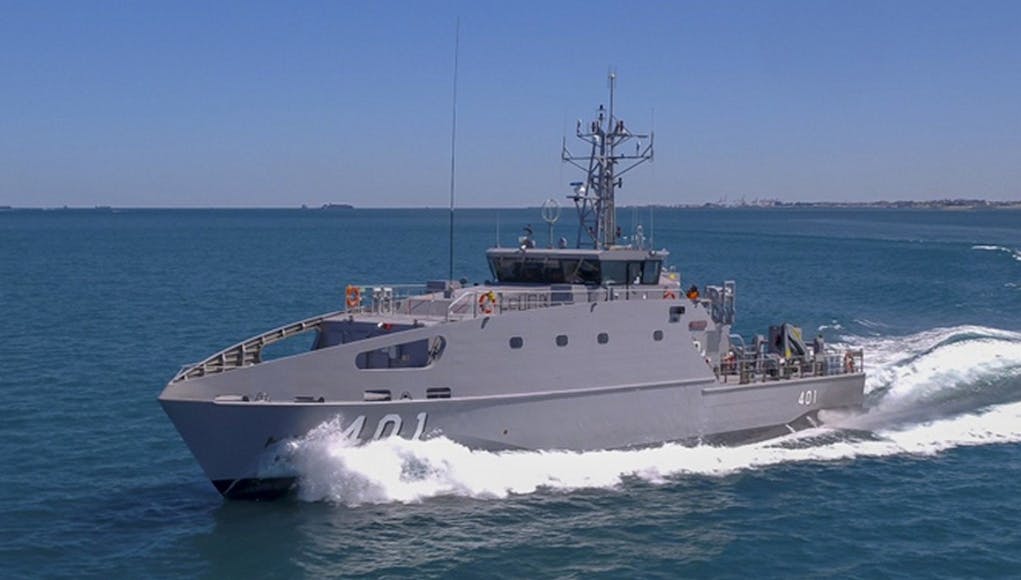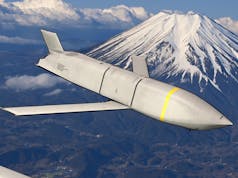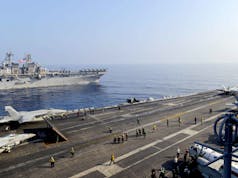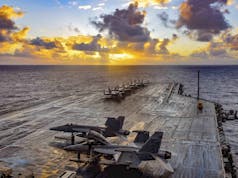The Australian government has handed over the first of twenty-one new build Guardian Class patrol boats being delivered under the Pacific Patrol Boat Replacement program to regional neighbours.
Built by Austal Ships in Henderson, WA the first recipient will be Australia’s former territory Papua New Guinea which is scheduled to receive four vessels.
The lead vessel has been named HMPNGS Ted Diro, in honour of the first commander of the Papua New Guinean defence force, and replaces the recently decommissioned HMPNGS Rabaul. The new vessel will have a maximum speed of 20 knots and is designed for a crew of 23 sailors and officers. Though delivered unarmed it has the capacity to mount an autocannon on the foredeck and two machine guns on the bridge wings. The new class also features a stern ramp for launching pursuit and boarding vessels.
Speaking at the handover ceremony, the Australian Minister for Defence Industry, Steven Ciobo, MP said the project highlighted the close relationship between Australia and her Pacific Nation neighbours.
“These Guardian Class Patrol Boats are being gifted to 12 Pacific nations and Timor-Leste as part of Australia’s Pacific Maritime Security Program,” he said.
“It really speaks to the nature of the relationship not only between Australia and PNG, but also between Australia and all Pacific island countries and Timor Leste.”
The total build project for twenty one vessels is worth more than $350 million, a significant investment by the Australian government to support regional security and also its own domestic shipbuilding industry. As well as the Henderson Yard constructing the vessels, Austal has secured a seven year maintenance contract for the fleet from its Cairns Yard.
The vessels replace those delivered under the Pacific Forum project that were donated from the late 1980s, with the Guardian class incorporating many changes and features based on experiences with the earlier vessels. These include easier capacity for simple maintenance to be done as the basic facilities available at their homeports and improved fuel efficiency to ensure the recipient nations can keep them at sea as much as possible. The second vessel is expected to be commissioned in April 2019 and will be delivered to Tuvalu. After that Austal expects to deliver a vessel every four months through to 2023.










What a great idea and an amazing looking craft, and I see the fitted for but not with trend is going international, why can’t we sign up to this excellent programme and get about 8. We can name them each after historical guardians of the crown.
just a bigger looking archer
historical guardians of the crown ?
Lancelot???
Too busy buying our patrol ships off Damen in the Netherlands. Great to see Austal going from strength to strength they are making warships for the US navy now. As great as the T26 is I’ve always felt BAE is not focused enough on designing and building warships, BMT seem to put more effort just no in the same league as their larger rivals.
BMT never disclose prices, build time, or ever where they’ll build their concept ships
Their Cape Class would have been a very useful addition patroling our waters.
https://en.wikipedia.org/wiki/Cape-class_patrol_boat
They wouldn’t last very long in UK waters. Aluminium is not the best material for warships especially in heavy seas.
USN LCS vessels (Trimaran) have big issues with cracking as do the Catamaran High speed vessels and they are all made by AUSTAL.
Corrosion is also an issue. If there are any pinholes in the paint scheme internally or externally then the plate starts to get eaten away. In warmer climes this is a big issue as the sea water evaporates and concentrates into highly corrosive brine that accelerates the problem.
FYI Austal are actually using steel for the he Guardian Class hulls.
It’s not a bad way to provide ‘foreign aid’. Building regional relationships and security while creating jobs for Australian ship builders.
Any chance the UK could redirect some if its foreign aid budget alOng these lines?
FYI Austal are actually using steel for the Guardian Class hulls.
It’s not a bad way to provide ‘foreign aid’. A win-win building regional relationships and security and jobs for Australian shipbuilders.
Any chance the UK could redirect some of its ‘foreign aid’ budget along these lines?
Thank you Gunbuster,
Would a steel version cost much more for UK waters compared with an aluminium build?
No additional cost because the Guardian Class are already steel hulled.
Australia is building 21 vessels for $350 million (or 195 million pounds), although bearing in mind this is sans weapons.
For that cost the UK could replace the Royal Navy’s entire Archer Class patrol boat fleet of 16 boats and increase the number of hulls by 5 with new build hulls (the Archers were commissioned from the mid-80s) with a vessel with five and a half times the range and around five times the tonnage with better sea keeping.
Could be a handy piece of kit post Brexit.
Thank you Oscar Zulu,
My comment above referred to the Cape Class in steel as opposed to aluminium.
Any thoughts on this?
They look cheap and nasty. Why is everyone saying they look great vessels? They aren’t in the same league as the RN new OPVS.
No gunny bangbangs
Aren’t they actually hilariously ugly?
Beauty is in the Eye of the Beholder, Personally I loved the Type 21, and so much faster than the Leander’s , felt like a formula 1 car at full chat.
Lets buy 100 and fit them with……
I’d like to emphasise the point that we should be using our foreign aid/international development budget to support British heavy industry. There’s plenty of demand for opvs amongst the poorer nations and we should use the development budget to either provide loans or to subsidise the cost of British-built opvs and other industrial/engineering products
I agree, but we can actually start by using it to give our farmers good prices on spare produce (50% root crops not being lifted annually) and containerised homes, solar panels, water filtration etc.
We should insist that our foreign aid is in product made in Britain. I dont care about us meeting some UN target I care about us doing the right thing.
All of this should be delivered by a set of RFA humanitarian ships (Karel Doorman’s) that can be used by the UK Armed forces if needed. Thereby we have a standing capacity that is being used as opposed to being tied up
British company Carmac has a range of patrol boat designs.
Finnish Border Guard has 81 coastal patrol boats. Eighty one………
There are lots of patrol boat designs out there. One design I would consider beyond the typical military / police designs is Fassmer’s 46m SAR design. Self-righting and designed for the worst weather.
What U.K. options are there if any?
Looking at that Fassmer Site I see a 40m (or 41m for the variant designed exclusively for the Danes) but not 46m. Is it the 40m one that you mean (https://www.fassmer.de/en/shipbuilding/products/navy-vessels/40m-coastal-patrol-vessel-cpv/) or is there another design that I didn’t find on the site?
Looking at that 40m vessel I am left wondering how much additional length & displacement would be needed for a UAV hanger and deck. In today’s age where some sort of as-wide-as-possible area surveillance and policing is what such vessels are doing almost all the time it would seem to me to be a good feature to have and perhaps a gap in the market that a design from someone like BMT could fill.
I’ve been impressed with how BMT has managed to get a decent flight deck, dedicated UAV hangar and good aft deck all coexisting in the Venari 85 design. The Venari 85 is too big a size-step up for the sort of vessels discussed here and its flight deck is designed to be able to accommodate something like a Wildcat but if one were to want to stay in the 40-something metre length range then I wonder whether going up to 45/46/47m would allow space for UAV facilities. Given the constraints I suspect a dedicated flight deck would be impractical (but maybe not) so maybe it would be a case of a stretched and carefully designed aft deck such that the part of it furthest forward (closest to the hanger in the superstructure) could be made clear of all obstructions sufficient to launch and land something like a Schiebel S-100 or catapult/capture something like a ScanEagle with the hangar space created by using the additional below-decks space that a stretch would provide to relocate existing superstructure space thus freeing up some superstructure internal volume for a hangar which would also be designed to be multi-purpose so it wouldn’t be dead space if a drone wasn’t embarked.
I’ve no idea what would be possible at an affordable price, which should be another absolutely key design goal, but it would be an interesting design project and maybe an interesting opportunity for U.K. industry.
Oops. Sorry Steve, I somehow missed your reference to Carmac before posting and asking about U.K. alternatives. I obviously jumped onto my drones hobby horse too quickly!
Or Camarc even. Third time lucky!
Sorry yes it CAmarc. 🙂
If we are just patrolling the UK EEZ or areas like the Fawklands etc it would be easier to launch drones from land and just have a data link to the ships. I think that’s why we have not see a big take up in sea launched drones, probably too much risk of them and their expensive equipment ending up in the sea.
Oops. That’s an excellent point. Still a key asset for more ocean-going River Class sized vessels but perhaps no point in trying to shoehorn the capability into a 40-something metre vessel.
Sadly though, unless there is stuff not known about or that I’ve missed, there seems to be little going on re initiatives for the U.K. to make use of drones in U.K. EEZ. There seems to be some quite sophisticated stuff available as far as drone-mounted sensor packages are concerned which could surely greatly enhance surveillance capabilities (couldn’t they?) and the drone operating heights would, I assume, be below the commercial airlanes.
I know, you would think the English channel would be patrolled 24/7 by multiple drones (maybe it is and we just don’t know) to counter things like drug and people trafficking. There must be a height they can operate safely at without being a risk to air traffic.
We could build ‘amphibious’ drones and fit flotation devices to aid recovery. If they need to ditch we could then recover them.
But patrolling by drone is a bit like policing by CCTV. It is an aid not a replacement for bodies on the ground, um, I mean hulls in the water!
Rivers are OPV which are an entirely different class of vessel from inshore or coastal patrol craft. The cut off point is somewhere around 600 tons approximately. But it all depends on the design and the country as there is no strict definitions; if a boat goes over the horizon is it patrolling the ‘ocean’ as it were and so on. And then we have the technical definition of ships and boats; a ship being a vessel with more than one continuous deck above the waterline. (That is why submarines even big ones are boats.) This rather like all this business with frigates and destroyers as ‘names’ for ‘classes’ or ‘types’ of ship all a bit confusing.
“or 41m for the variant designed exclusively for the Danes”
Contrary to popular belief, the Diana class patrol vessels of the RDN is not actually a Fassmer design, despite the superficial resemblance to some of their patrol boats. The 43m Diana’s were wholly designed and built in Denmark by Hauschildt Marine/ Knud E. Hansen and Faaborg Yard respectively.
https://www.knudehansen.com/reference/diana-class-for-the-danish-navy/
http://www.navalhistory.dk/English/TheShips/Classes/Diana_Class(2007).htm
Getting ready for this…
https://news.usni.org/2018/11/23/australia-u-s-set-expand-papa-new-guinea-naval-base
Lombrum was a massive USN anchorage and base during WWII. Very strategic location to help interdict PLAN assets operating from the SCS. One of a string of war era bases being rehabbed and reoccupied by the U.S.forces in recent years.
Cheers!
A base on Manus Island isn’t necessarily an advantage for Australia in accessing the South China Sea.
Darwin, which already hosts established RAAF and RAN infrastructure as well as an Australian army brigade and the USMC rotational force is actually closer to the SCS than Manus (e.g. 3150 kilometres to Fiery Cross Reef versus 4,000 kilometres – a 1,700 k difference for a RAAF return sortie).
Manus offers two advantages as a base. Firstly building a up a basic capability there helps strengthen the relationship with PNG and helps keep them ‘in the tent’ while pushing back against China’s soft power influences or their own basing ambitions in the region.
Secondly it provides entry to the SCS from the east rather than from the mainland Australia to the south. Indonesia effectively forms a barrier to Australia’s access to the north if they should choose to deny Australia overflight rights or close access of seaways like the Sunda Strait.
While Australia has the military capability to force the point, a conflict with Indonesia would not be in Australia’s best long term interests and Manus would offer a work around.
https://en.wikipedia.org/wiki/Lombrum_Naval_Base
Steve
Have to say the Fassmer 90m OPV is definitely what we should have been getting, having never seen this before I am embarrassed that we end up with Rivers when this design is out there in a smaller footprint. I dont know how much they cost, but suspect less than a River.
Just shows what can be done
https://www.fassmer.de/en/shipbuilding/products/navy-vessels/90m-opv/
Would even go as far as to say this could be a T31 design and accept some limitations
Comparing the two ships, River 2 looks to trade off the Fassmer hanger for a larger Merlin sized landing deck and a crane for fisheries and probably Caribbean humanitarian duties – unloading where there is no dockside crane. It also has a practical ‘constabulary’ 30mm rather than what looks like a OTO 76mm which is less likely to be used. Also I think R2 can be routinely sailed on patrol duties with a crew of around 30. I reckon it’s horses for courses. R2 is more what the RN needs.
As for Type 31 I am hoping for Meko A-200s built in Belfast 🙂
“or 41m for the variant designed exclusively for the Danes”
Contrary to popular belief, the Diana class patrol vessels of the RDN is not actually a Fassmer design, despite the superficial resemblance to some of their patrol boats. The 43m Diana’s were wholly designed and built in Denmark by Hauschildt Marine/ Knud E. Hansen and Faaborg Yard respectively.
https://www.knudehansen.com/reference/diana-class-for-the-danish-navy/
http://www.navalhistory.dk/English/TheShips/Classes/Diana_Class(2007).htm